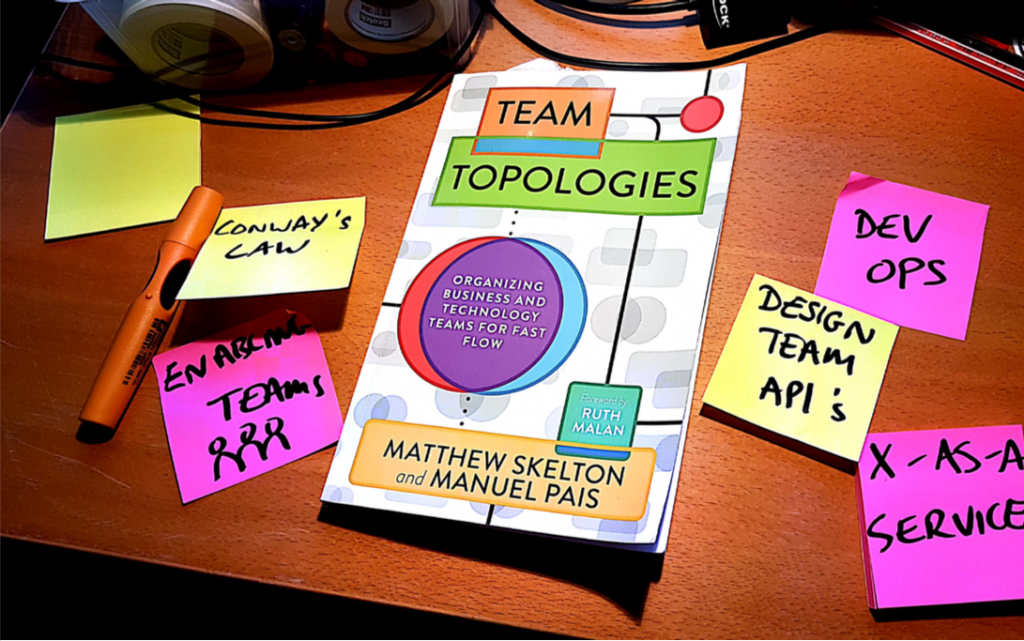A book for managers, about architecture
Ruth Malan re-stated Conway’s law like this: “If the architecture of the system and the architecture of the organization are at odds, the architecture of the organization wins”. As a technical leader, that really caught my attention. The sphere of things I should be able to influence in order to do my job well just grew!

I read that quote in the book “Team Topologies” by Matthew Skelton and Manuel Pais. I think it’s a really interesting book and introduces several ideas that were new to me at least. They deserve a wide audience within the software industry. In this article I’ll give you some highlights, and hopefully tempt you to read the book for yourself.
This first idea perhaps isn’t so novel, but it is the basis for the rest, so worth mentioning first. You should use the team as the fundamental building block for your organization. Rather than thinking about hierarchies or departments that get re-organized from time to time, think about building close-knit, long-lived teams. Adopt a team structure that is aligned to the business and adapts and evolves over time.
Conway’s law
When designing a team structure for your organization you should take into account Conway’s law. Your team structure and your software architecture are strongly linked. You should design team responsibilities and communication pathways. Skelton and Pais suggest there are four fundamental team topologies, ie kinds of team. The main one is ‘business stream-aligned’, the other three have supporting roles. The way they describe a stream-aligned team seems familiar to me. It’s like a DevOps team or a feature team. I think the name is better though. It’s a team that’s aligned to a single, valuable stream of work. They do everything needed to deliver valuable software to customers, gather feedback from how it’s used, and improve the way they work.
The other three kinds of team exist to reduce the burden on those stream-aligned teams. Skelton and Pais introduce the idea that good organization design requires restricting the amount of ‘cognitive load’ each team is expected to handle. Software systems can become large and complex and can require an overwhelming amount of detailed knowledge to work on them. This really resonated with me. I’ve worked on teams where the amount of software we had to look after was just too much to cope with. Important work was delayed or missed because we were overburdened.
The other three types of team are:
- Platform
- Complicated Subsystem
- Enabling
There is a fuller description of each in the book of course, but to summarize – platform teams provide a self-service tool, API or software service. Enabling teams support other teams with specialized knowledge in particular techniques and business domains. Complicated subsystem teams look after a particular component of the software that needs specialized knowledge, like an optimizer or a machine learning algorithm.
Following from the idea of Conway’s law in particular, is the idea that you should have only three ‘interaction modes’ between teams. Restrict the communication pathways to get the architecture you want, and to avoid unnecessary team cognitive load. Skelton and Pais suggest teams should work together in one of three ways:
- Collaborate
- Facilitate
- Provide X-as-a-Service
Collaboration means two teams work closely together, have a common goal, and only need to work this closely for a limited time. (Otherwise the teams would merge!) Facilitation is about one team clearing impediments that are holding back the other team. X-as-a-service is a much looser collaboration, where one team provides something like a software library or api to another team. The way teams interact with one another will evolve over time, and consequently your organization will also evolve.
I thought it was a good sign that I could imagine how my own work would fit into an organization designed this way. I think I would fit well into an Enabling team that would support stream-aligned teams through facilitation. We would work with several teams over time. My particular role is to facilitate a team to clear impediments around technical debt and code quality, and learn skills like Test-Driven Development.
Team Topologies really does make organizational design feel like you’re doing architecture. Skelton and Pais have pretty diagrams throughout their book with colours and patterns and lines and boxes describing various organizational designs. It’s all very attractive to a software developer like me. I think the intended audience is managers though. People who are designing organizations today. I really hope some of them read this book and are inspired to involve technical people in important organizational decisions.







